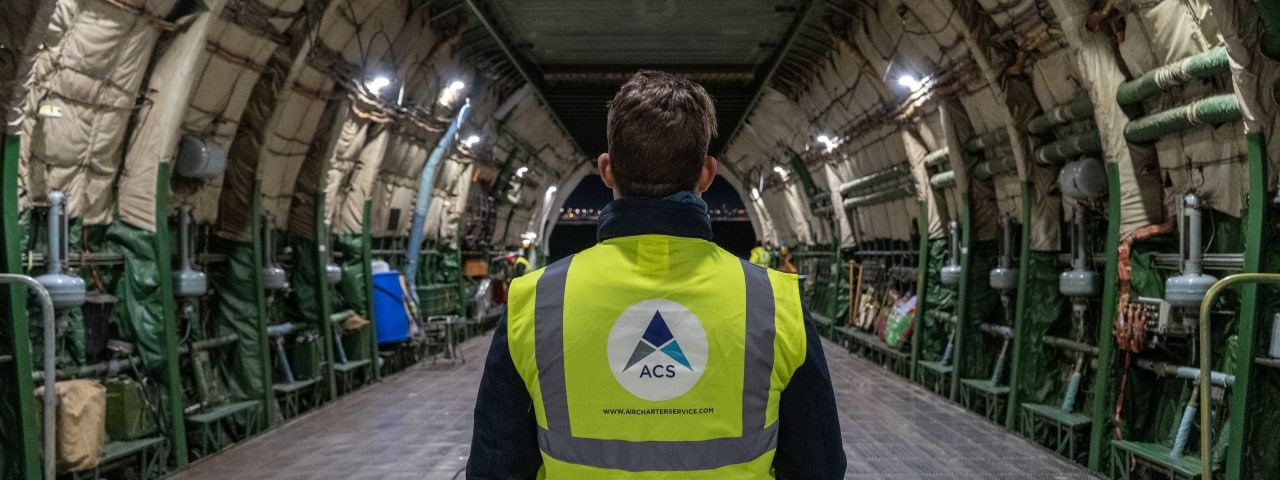Is China's export slump here to stay?
Despite China’s struggles to contain COVID-19, the country’s manufacturing and export industries remained strong throughout the pandemic.
“High worldwide demand for PPE, rapid antigen tests and goods such as cars and electronics has kept our cargo charter team extremely busy over the last few years,” says Oscar Liu, cargo director for ACS in Beijing (pictured below).
“The vast majority of global air cargo transport before the pandemic was completed via the belly of passenger aircraft. When these aircraft were grounded, organisations had to look for alternative solutions to keep supply chains moving. And that’s where we came in, sourcing specialised cargo aircraft and organising hundreds of cargo charters to help fill the void.”
However, the export boom that carried China’s economy through much of the pandemic has lost momentum, with exports falling by 8.7% in November 2022 compared to the previous year. This was followed by a 9.9% drop in the final month of 2022, and another unexpected 7.5% fall in May 2023 according to data from China’s customs bureau.
What’s impacting China’s exports?
Before China relaxed its COVID-19 restrictions in late 2022, U.S. manufacturing orders from the country were down 40% and container ship carriers were suspending services to balance supply with demand as part of an ‘active capacity management’ strategy.
“A lot has been made about lower global demand for Chinese goods in recent months, especially from the U.S.,” says our Indo-China regional director, Stephen Fernandez. “And it’s true that demand has declined since mid-2022, for various reasons including rising interest rates, inflation and the threat of recession. We’ve also had fewer requests to deliver lateral flow tests as governments have relaxed their COVID-19 testing policies.
“However, while U.S. demand has stalled, much of the recent decline in China’s export volume can be attributed to internal factors. The country’s zero-COVID policy continued throughout most of 2022, which saw factories shut down for weeks and a struggle to keep up with global demand.
“Then, when the strict policy was lifted and international travel resumed in late 2022, factories struggled with high levels of sick leave as workers caught the virus. This issue settled quite quickly, but factory production slowed again for Chinese New Year in January as workers travelled to celebrate with family for the first time in three years.
“Ultimately, though, while Western demand may remain comparatively low in the coming months as countries grapple with their respective post-COVID economies, we fully expect Chinese exports to rebound to their usual high levels. It’s normal to see a seasonal decline around Chinese New Year and, although recent export statistics appear concerning, they’re being compared to the unusually high numbers posted around the same time in 2021.”
“Any news of downward export trends during 2023 needs to be understood in the context that China’s economy will likely still grow at least 5% this year. No other economy of this size is growing at this pace.”
New emerging markets
Despite a late export slump, China’s trade surplus still hit a record $878 billion in 2022. While China remains the world’s biggest manufacturer and exporter by some margin, according to MDS Transmodal, the country’s global share of certain consumer goods exports has been gradually falling, with clothing and accessories (-4%), travel goods and handbags (-13%), furniture (-11%), and footwear (-7%) seeing lower output in 2022 than 2016.
“Chinese land and labour costs have risen in recent years,” says Oscar. “This, combined with various other factors, has pushed certain industries to seek manufacturing locations elsewhere. Some now produce goods closer to home, while others have found new sites in countries like Vietnam (which experienced a record export turnover of $371.5 billion in 2022, up 10.5% from the previous year), Cambodia, Malaysia, Bangladesh and India.”
“To combat this, Chinese manufacturers have started diversifying what they produce, transitioning from goods like furniture and clothes to other products like high-tech equipment and electric vehicles. These new growth markets in China and across Asia are impacting the number of charter requests we’re receiving in the region and around the world.”
New charter requests
“We’ve seen an uptick in inquiries about private and group charters. Of course, this has a lot to do with the fact that national and international travel restrictions were relaxed in 2022, but we’re also receiving more charter requests for business executives travelling to trade shows and factories in search of new trade routes and manufacturing locations,” says Oscar.
Stephen says this trend has been noticed in Southeast Asia as well as mainland China. “In 2022, our passenger charter divisions saw a 166% increase in enquiries and bookings compared to the pre-pandemic levels of 2019.
“Part of this growth can be attributed to our Singapore office opening its doors just before the pandemic. But we’ve also seen huge increases across the region, particularly in the Philippines, Cambodia and Malaysia.”
Once companies have established new manufacturing locations, they often need cargo charters to fill the void if issues arise. “Traditional Chinese trade routes have been established for decades, with goods mostly transported via scheduled sea freight,” Oscar says. “Setting up new supply chains often comes with teething problems, especially with today’s scheduled freight disruptions. When goods need to be moved quickly at short notice, a cargo charter is the fastest solution.”
How ACS fills the void
“Our team (pictured above) just celebrated a decade of operation in Beijing, while our Hong Kong office has been open for almost 15 years,” concludes Oscar. “Over this time, we’ve built up strong supplier relationships and industry expertise in the Asia and Pacific region. This, along with our unrivalled access to aircraft all over the globe, means we can always source the right aircraft, at the best rates, for each client’s unique requirements.
“Our contacts and experience also mean we’re best-placed to deliver complex and last-minute charter solutions. When we get a call from a customer needing to move cargo urgently to keep supply chains moving, our team can often have an aircraft in the air within 24 hours to complete the charter in double-quick time. We also offer an end-to-end service, organising everything from documentation to onboard couriers and ground transportation.
“While we continue to go above and beyond for our clients in China as the country adapts to a post-COVID world, Air Charter Service’s global network of offices is perfectly placed to help fill the void as new manufacturing supply chains are set up across the Asia and Pacific region and around the world.”
Contact one of our team today to learn more about how we can help fulfil your cargo charter requirements.

 With the export boom that carried China’s economy through much of the pandemic losing momentum, our charter experts in the region discuss whether the slump is here to stay and what it means for the air cargo market.
With the export boom that carried China’s economy through much of the pandemic losing momentum, our charter experts in the region discuss whether the slump is here to stay and what it means for the air cargo market.






